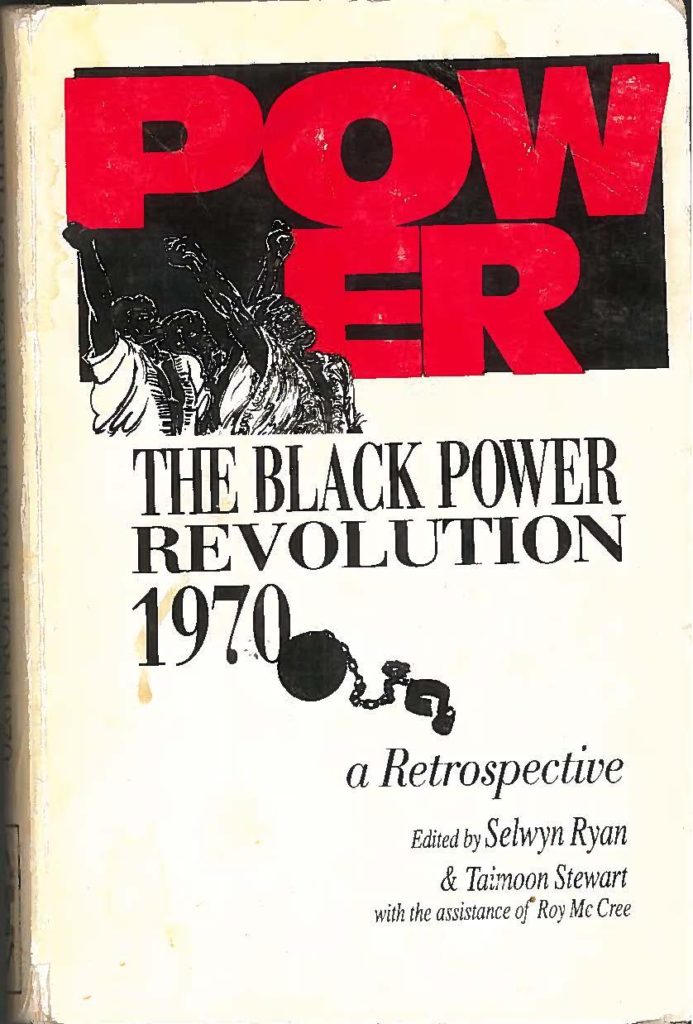|
Getting your Trinity Audio player ready...
|
Reading Time 3 mins
January 16, 2020
I arrived at Avenue X around 3 p.m. and collected the book from my friend. On the return trip, rather than continue reading the Times, I decided to read my recently-retrieved book–The Black Power Revolution 1970: A Retrospective–aware that I might stand out even more. Engrossed in reading Selwyn Ryan’s overview…
 In 1970, young Caribbean Blacks, like their brothers in the Americas, were preaching the word of Garvey though the language was more radical. What they wanted was… Reorganization of the Caribbean economies on a regional basis with black people as the central focus of development strategy [aimed at] the alleviation of the black millions at the bottom of the social and economic ladder….
In 1970, young Caribbean Blacks, like their brothers in the Americas, were preaching the word of Garvey though the language was more radical. What they wanted was… Reorganization of the Caribbean economies on a regional basis with black people as the central focus of development strategy [aimed at] the alleviation of the black millions at the bottom of the social and economic ladder….
…while trying to block out the noise of the train as it sped on the above-ground tracks, I remembered V. S. Naipaul’s 1970 dismissive view of the Caribbean as “half-made societies… the Third World’s third world.” Pondering how far the Caribbean Revolution had turned Naipaul’s seemingly sardonic claim on its head, I continued reading…
A termination of the client relationship between Caribbean governments and Britain, France, [and] the United States…. The restructuring of the educational system… informed by the principle that black is beautiful [and] that the historical experience of black people everywhere was a legitimate and indeed an indispensable part of any school curriculum.
…and talking back to the text while reflecting on my high school years spent demonstrating for – what would now be called – equity and social justice in the streets of Port of Spain, Trinidad’s capital, I began wondering how to commemorate the 50th anniversary of the Revolution.
Turning the page to Khafra Kambon’s recollections, I continued reading…
On March 12, one of the most dramatic demonstrations of the February to April 1970 period took place–the Caroni March, a 33-mile march from Port of Spain through Caroni to Couva. Thousands of Africans were mobilized for this journey through the predominantly Indian heartland of the country. NJAC was determined to achieve a unity of concept, purpose, and action among Africans and Indians…
….partially blocking out the world around me, as I suspected other commuters were doing by immersing themselves in the digital world. Instead, I’d look up intermittently to observe the unpredictable outbursts of the occasional ‘character’ passing through the carriage, still prevalent today as in the past.
When the train stopped at Church Avenue Station, I saw a commuter board the train with a magazine. He was in his mid-thirties. Changing my seat to get closer to see the magazine, I could discern on the cover of the glossy, oversized magazine cover: CULTURED. For the second time on my two-and-half-hour odyssey, I felt a sense of camaraderie with a rider in the way I did on my previous underground escapades in the 1970s and 1980s. It was an outlandish cover with such a stunning portrait of a new-age character that led me to search for the magazine. Unfortunately, like me before my subway encounter, none of the remaining kiosks in mid-Manhattan and Hudson News in Port Authority had heard of the magazine. I persisted in searching for a few days until I found the Summer 2019 Issue at Magazine Cafe on W 37th Street in Manhattan.
Still, I wonder how much of a statement the underground reader may have made by displaying CULTURED and perhaps unwittingly challenging the anonymity of underground electronic screens. Could the subliminal message have been: “Print magazines won’t die!”?
The commuter’s pose led me to ponder how this age of connectivity is fashioning an unconnected digital culture of subway ‘reading’: a new chi that no longer facilitates implicit communication or unintended sharing in that crucible of deceptive otherness in the past, fomented an unquantifiable visual dialogue.
Today, I wonder how much my public education was arrested once I drifted away from the underground reading subculture where physical newspapers and books, even graffiti, competed for and informed and enlarged this straphanger’s vision.
—————————————————————————————————-


Louise Rougier on January 24, 2020 at 11:41 pm
l totally identify with all aspects of the underground commute and commuters in the eighties; I received lots of advice in my initiation as a new subway rider, including warnings from friends and family members. My favorite was, ‘no eye contact with anyone, especially the hard cold people that were some of the subway riders’. Yet these warnings faded quickly. The subway became like a second home; a familiar neighborhood with a silent comradery which gave me a warm and comfortable feeling. While the men read their folded newspapers the ladies heads would be buried in one of the NY bestsellers; if you looked up for a second, you would see a large percentage of women reading the same book and might share a smile from something we just read. Most ladies might remember: Lucky (Jackie Collins), Changes (Danielle Steele) or Hollywood wives (Jackie Collins). These books made for a quick and enjoyable ride; sometimes we would even miss our stops being so enthralled in our fantasy world. No electronic devices for us, we were proud to show our book covers. I ask the question; have we evolved for the better or worse?
Jemma Holder
As always you nailed it, your description of your journey, I mean literally, was so descriptive and on point. So many immigrants will totally relate to this piece, it might not be the same story but it will truly bring back amazing personal stories of their journey navigating their early acclimatizatión to the USA.